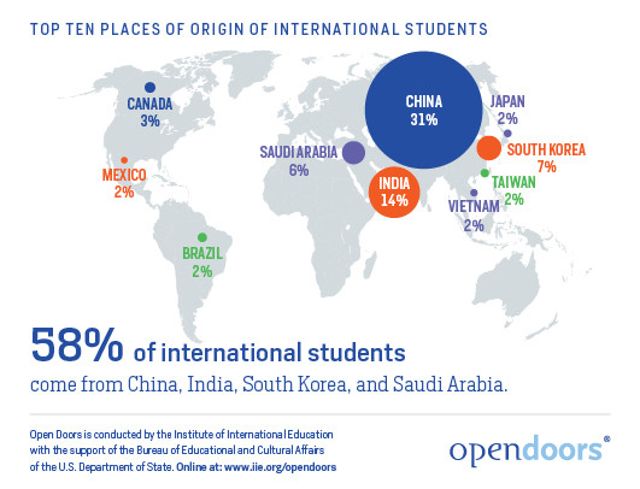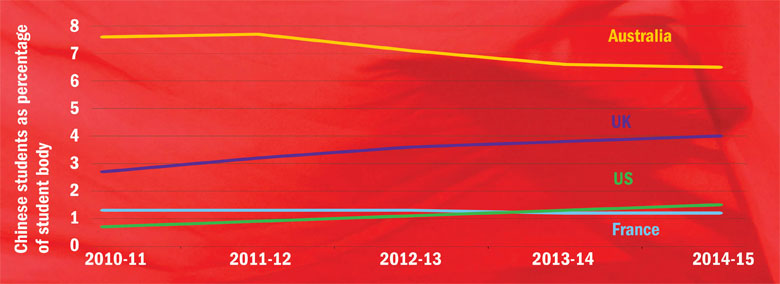China – The Largest Untapped Market for Outbound International Students
Some 40 years ago, China accounted to 0.5% of global trade. Today, China is the world’s leading economic power and home to nearly 600 billionaires. In recent years, China’s middle class has experienced a booming growth with more than 27 million families earning annual income above $35,000.
At the same time, there are considerable challenges lying ahead for China. The country’s external debt is growing faster than USA’s debt used to grow before the 2007 big financial crisis. And while there is no doubt that the Chinese economy is nowhere near the risk of facing such a sudden collapse, the recent slowdown raises a lot of questions on the stability and sustainability of the current model.
From a demography perspective, a serious decline in China’s youth is expected to take place in the next 35 years. By 2020, the number of Chinese people between 18-23 years of age is expected to drop by 20%. On top of that, a further 20% decrease is projected to happen between 2040 and 2050.
Other well-known issues China has been struggling with include severe pollution, natural disasters and rising levels of unemployment. This rather peculiar combination of favourable and unfavourable conditions has many implications, but when it comes to education, the message is clear: China is the key player on the global student mobility scene and the largest untapped market for outbound talent.
Student Mobility Trends
China has long been the undisputed #1 exporter of international students in the world. According to UNESCO data, a total of 712,157 Chinese students were studying abroad in 2013 alone.
Today, Chinese students represent the largest segment of the global international student body and are the world’s most mobile student group within tertiary education.

China’s global leadership is extensively visible in its relationship with the US. At least 1/3 of all Chinese outbound students go to the US. This flow brings on significant impact on the country’s local economy. Chinese students in the US pursue undergraduate studies, graduate studies and vocational training in more or less equal proportions, with demonstrated interest in STEM fields (42.4%) followed by business and management (26.5%) and social sciences (7.8%). In the words of the current Chinese president, Xi Jinping, “the exchange of students will promote better understanding and friendship between the two countries as well as a healthy bilateral relationship”.
Recent years have seen many US institutions focus on diversifying their international campuses so that they no longer have their majority of international students coming from one or just a couple of nationalities. For the vast majority of underrepresented educational institutions, however, China remains a huge untapped opportunity for internationalisation and diversification.
The other most popular overseas study destinations for Chinese students are the UK, Australia, Japan and France.
Last year data from the Chinese Ministry of Education reveals that nearly 90,000 Chinese students chose to study in the UK. More than 91,000 went to Australia, about 95,000 enrolled at colleges and universities in Japan and over 50,000 pursued France.

Source: “Chinese student market: can the West weather a perfect storm?”, Times Higher Education
Although the country’s economy has recently slowed down, its expanding middle class means more Chinese families are willing and able to invest in tertiary education abroad. There is a growing interest in pursuing degrees in arts, as many Chinese students and their families begin to perceive the creative industries as promising paths for career development.
Secondary education overseas is picking up as a trend among wealthy Chinese families, too. In 2015, 25,000 Chinese high school students enrolled in US boarding and high schools, a whopping 30% increase on 2014. The number of Chinese high-school students in Australia is also growing rapidly.
Apart from the slowing economy, the biggest challenges for Chinese student mobility are the country’s ageing population and the prospect of a dismal political future. Western culture has come under unprecedented scrutiny by the Chinese government and legislation. At the beginning of 2015, education minister Yuan Guiren even pledged to ban university textbooks that promote “Western values”. There might indeed be a possibility for international education to become a highly politicized topic in China. Nevertheless, the staggering numbers of Chinese students abroad keep on rising, and for the time being, the country’s leadership on the global outbound student mobility landscape remains undisputed.
Scholarship Opportunities
Chinese students are probably the luckiest students in the world when it comes to availability of scholarships for studying overseas. There is a really big number of scholarships and funding opportunities for Chinese students offered both by China’s government and education providers from all corners of the globe, so we will try to focus on the most important ones below. China also has a remarkable policy for encouraging its international students to return, including support for professional development and a variety of other incentives.
Support offered by the Chinese government:
CSC – China Scholarship Council
The China Scholarship Council is a local non-profit organization affiliated with the Chinese Ministry of Education. The Council provides funding and financial assistance to Chinese students wishing to pursue educational opportunities abroad, as well as to foreign citizens who want to study in China.
A wide range of study abroad scholarships for Chinese undergraduate and graduate students, as well as for PhD, postdoctoral, visiting and advanced scholars are available across the regions of Europe, America, Asia and Oceania.
Areas of study encompass health, biomedicine, maths, physics, technology, agriculture, English teacher training, leadership and more.
In order to be eligible for funding from the China Scholarship Council, students must meet the following criteria:
- at the time of application, be a citizen and permanent resident of the People’s Republic of China;
- not be currently working or studying abroad;
- return to China upon completion of studies;
- fulfill academic entry requirements set out by the hosting education provider, including a high level of English language proficiency;
- fulfill all other requirements as outlined by the CSC
Chinese Ministry of Education
The Chinese Ministry of Education makes every effort to encourage students who have studied abroad to return to China and contribute their knowledge, achievements and experience to the benefit of the local community. Returning students usually occupy high positions in the high-tech industry, finance, insurance, trade, management and education.
The country’s policy for supporting and facilitating returning students in their career development and for ensuring “freedom of coming and going” has resulted in several programs and initiatives:
- “The Fund for Returnees to Launch S&T Researches”
- “Program for Training Talents toward the 21st Century”
- “The Chunhui (literally, Spring Bud) Program”
- “Changjiang Scholar Incentive Program”
- “Program of Academic Short-return for Scholars and Research Overseas”
Opportunities provided by external parties:
Chinese students looking for financial support to study abroad enjoy a really wide range of international scholarships and other funding opportunities. Many universities across US, Europe, Australia and Asia offer scholarships for Chinese students who demonstrate outstanding academic achievement and potential.
To get a small glimpse of some of the available scholarships out there, click here or here.
Cultural Highlights
China is one of the world’s oldest civilizations with 3,600 years of written history. The country has rich traditions, deep-rooted cultural values and worldwide fame for its cuisine, architecture, martial arts and so much more. Local culture is fascinating but also very different from the Western world, no matter if it comes to business or pleasure.
Chinese people are extremely devoted to the concept of collectivism. From a very early age, their children are taught that the individual is dependent upon the group. Naturally, the family is the most important unit in the Chinese society.
If you seek to establish a successful business or other social relationship with the Chinese, you must first build a foundation of trust. The Chinese language has two words for “trust” – one meaning “from the heart” and the other “from the head”. Therefore, you need to display both reliability and capability, as they are both equally important in the Chinese world.
Like in other Asian cultures, respect and discipline have a very prominent role in the Chinese society. Therefore, you should take into account the strict observation of formalities such as hierarchy, schedules and deadlines. Avoid emotional displays and any form of physical contact, including eye contact. In most social situations, such displays are considered largely inappropriate.
You have to learn to read between the lines as the Chinese style of communication relies to a great extent on indirect means and gestures. These include implied requests, suggestions, background, context, body language, facial expressions, etc.
Student Recruitment Tips
With all its challenges and recent controversies, China remains a golden opportunity for international student recruiters across all education sectors. The Chinese middle class is rising so fast that major cities are no longer the only source of students. Families from a growing number of 2nd and 3rd tier cities can now afford sending their children overseas. However, the unique characteristics of the Chinese market mean that student recruiters must have a special plan in place.
Make sure you base your marketing and recruitment strategies on current data. This includes China’s most important economic, geopolitical and demographic developments. Try and meet with local agents with proven expertise and experience, current students as well as recent alumni. This will help you understand motivations and get first-hand recommendations on good practices.
A key thing to have in mind when targeting Chinese students is that a Chinese-speaking admissions officer can be critical to your success. Fluency in the local language and knowledge of how Chinese students use Internet and social media will make your job much easier.
A well-designed and executed digital strategy is a must in times of such ubiquitous use of Internet, social media and smart devices. However, this alone is not enough. Digital efforts complemented by offline approach involving face-to-face communication such as educator-agent workshops and student recruitment fairs. The more senior the staff you send for such negotiations is, the better.
Always build your student acquisition strategy around future career opportunities and employability. Use reliable sources of data when talking to families. Put stress on destination country safety and general quality of education. Chinese culture is still very conservative and parents play a major role in the research and choice of education abroad. As long as you are well-informed and aware of your own international recruitment objectives, you should not be daunted by China’s size and complexity. Make sure you know what results you want to achieve and you will see your efforts rewarded.
***
Are you eager to learn more about international student recruitment opportunities in China? Then why not check our latest free e-guide “Diversify Your Student Body: China”? Simply click the button below to get your own copy today:
Stay tuned!











































